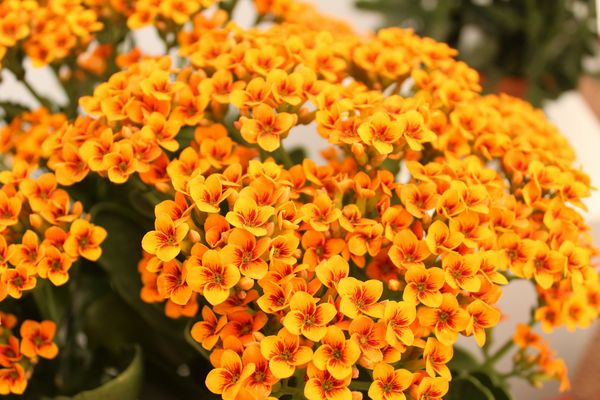Florist Kalanchoe Care Guide
How to grow and care for Florist Kalanchoe (Kalanchoe blossfeldiana)
The Kalanchoe blossfeldiana, commonly known as the Florist Kalanchoe, is a popular succulent famed for its vibrant blossoms and lush foliage. Originating from Madagascar, this plant is a favored choice for indoor gardeners due to its hearty nature and extended blooming period. With the right care, a Kalanchoe can brighten indoor spaces with its colorful flowers and can even rebloom, offering endless enjoyment.

Disclosure: This content includes affiliate links, which means we may earn a commission if you click on a link and make a purchase. As an Amazon Associate, we earn from qualifying purchases. This comes at no extra cost to you and helps offset the cost of running Leafwise. Please read our disclaimer for more info.
Table of Contents
Care
Light Requirements
Kalanchoe blossfeldiana thrives in bright, indirect light and is well-suited for indoor spots near windows. It can tolerate some direct morning sun, especially in cooler months, but should be protected from harsh afternoon rays in hot climates to avoid leaf scorch.
Watering
Water sparingly, allowing the top inch of soil to dry out between waterings. Overwatering can lead to root rot. During fall and winter, reduce watering as the plant enters dormancy and requires less moisture. Always check soil moisture before rewatering.
Humidity and Temperature
This plant prefers average indoor humidity and temperatures between 60–75°F (15–24°C). Protect it from cold drafts, and avoid exposure to temperatures below 50°F (10°C), especially near windowsills during winter.
Soil
Use well-draining soil, such as cactus mix or potting soil amended with coarse sand, perlite, or pumice. Proper drainage helps prevent soggy roots and root-related issues.
Fertilization
Feed once a month during the growing season (spring and summer) with a balanced, water-soluble fertilizer diluted to half strength. Resume fertilizing in early spring when new growth appears, and stop during dormancy in fall and winter. Watch for signs of over-fertilization, including salt buildup or browning leaf tips.
Maintenance
Pruning
Remove spent flowers regularly to encourage continued blooming and a tidy appearance. Trim leggy stems just above a leaf node to promote compact growth.
Cleaning
Wipe leaves occasionally with a damp cloth to remove dust and discourage pests. This also improves the plant's ability to absorb light.
Repotting
Repot every 2–3 years in spring using fresh soil, or sooner if roots grow out of drainage holes or the plant becomes top-heavy. These signs indicate the plant may be root-bound. Use a pot with proper drainage holes.
Propagation
Kalanchoe propagates easily from stem and leaf cuttings, ideally during spring or early summer when actively growing.
Stem Cuttings
Cut a healthy stem and allow it to dry for a few days until the cut end callouses. Plant it in well-draining soil and water sparingly until roots develop.
Leaf Cuttings
Gently twist off a healthy leaf and let it dry for several days. Lay the dried leaf on top of well-draining soil and mist lightly until roots and plantlets begin to form.
Common Issues
Pests
Kalanchoe can be affected by aphids and mealybugs. Signs include sticky residue, distorted new growth, or cotton-like clumps. Remove pests with a cotton swab dipped in rubbing alcohol, or treat with neem oil or insecticidal soap. Repeat weekly as needed until the infestation is resolved.
Botrytis Rot
- Symptoms: Gray mold on flowers or foliage, wilting, or soft spots.
- Causes: Excess humidity, poor airflow, or water left on leaves.
- Solutions: Remove affected areas, avoid overhead watering, increase airflow, and use fungicide if necessary.
Root and Stem Rot
- Symptoms: Mushy, dark roots or stems, foul smell, plant collapse.
- Causes: Overwatering, inadequate drainage, or containers without drainage holes.
- Solutions: Trim away damaged roots, repot in fresh, dry, well-draining soil, and ensure the new container has adequate drainage.
Yellowing Leaves
Yellow leaves often signal overwatering or insufficient light. Adjust watering practices and ensure the plant receives enough bright, indirect sunlight.
